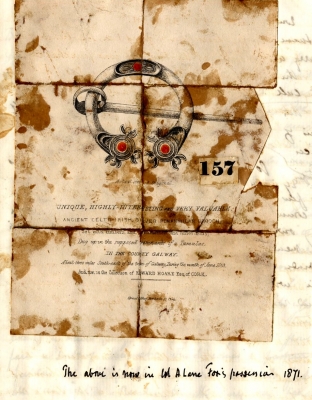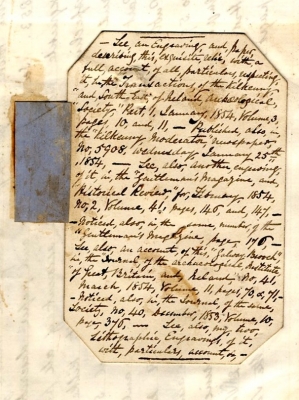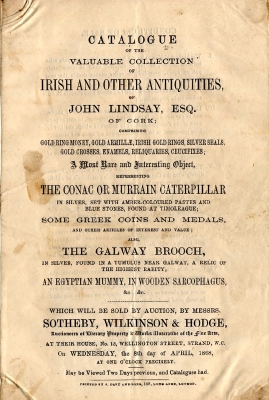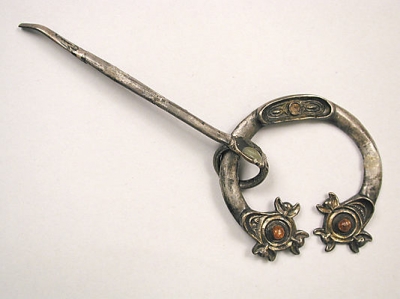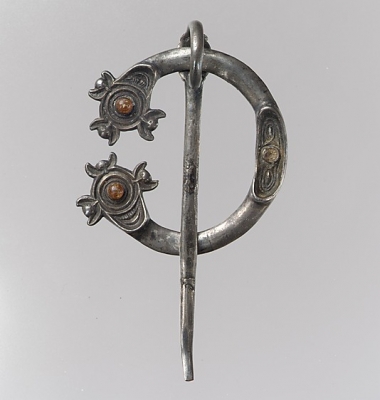To search the RPR site click here
Not all the items that Pitt-Rivers acquired before 1884 were donated to the University of Oxford. He is known to have withdrawn some items made of gold from the displays at South Kensington Museum just before transfer, presumably for his private collection and also to have withdrawn agricultural items, presumably to display at his private museum at Farnham, Dorset.
However, this account is about another object which does not fall into either category (exactly). It is one of the most significant that he is known to have retained for his private collection and it is the so-called 'Galway Brooch'.
What Pitt-Rivers said about the brooch
Pitt-Rivers kept a series of notebooks or commonplace books in which he recorded interesting things that he had read etc. In one of these books devoted to Personal Ornaments there is a section devoted to this object, which he acquired on 8 April 1868. Here is what he says in his notebook about it:
Printed drawing of Irish penannular ring brooch Ireland with red coloured stones marked 157 With printed text:
Unique highly interesting and very valuable Ancient Celto-Irish, silver penannular brooch (set with ambers and ornamented with wolves heads) Dug up in the supposed remnants of a Tumulus in the County Galway About 3 miles south-east of the town of Galway During the month June 1853 And now in the Collection of Edward Hoare, Esq of Cork’
Handwritten below
'The above is now in Col A Lane Fox’s possession 1871’
On next page:
THE GALWAY BROOCH
The following is the description given on the ticket attached to this Brooch at the time it was purchased by me at the sale of Mr Lindsays antiquities at Sotherby [sic] Wilkinson and Hodge on 8th of April 1868 The price I gave for it was £12.10s A Lane Fox
“Unique highly interesting and very valuable Ancient Celto-Irish, silver penannular Brooch set with amber and ornamented with wolves heads. Dug up in the supposed remnants of a tumulus in the County of Galway about three miles south east of the town of Galway during the month of June 1853. See an engraving and paper describing this exquisite relic with a full account of all particulars respecting it in the transactions of the Kilkenny ad South East of Ireland Archaeological Society Part 1 January 1854 Volume 3 pages 10 and 11 Published also in the Kilkenny Moderator Newspaper no 5908 Wednesday January 25th 1854 See also another engraving of it in the Gentleman’s Magazine and Historical review for February 1854 No 2 volume 41 pages 146 and 147 Noticed also in the same number of the Gentleman’s Magazine page 176 See also an account of the Galway Brooch in the Journal of the Archaeological Institute of Great Britain and Ireland no 41 March 1854 vol II pages 70 and 71. Noticed also in the Journal of the same society No 49 December 1853. Volume 10 page 376 See also my two [insert] orthographic Engravings of it with particulars account &c Represented also in the Hotel Journal of Archaeology No 19 July 1857’
‘TICKET TO WHICH THE BROOCH WAS ATTACHED AT THE SALE OF MR LINDSAYS ANTIQUITIES APRIL 1868 ALF’ [Ticket saying more or less what is said above about journal accounts glued into book]
Front page of Sotheby’s catalogue for sale glued into book: ‘… Also the Galway Brooch, in silver, found in a tumulus near Galway, a relic of the highest rarity …’
The brooch is not mentioned in any of the primary sources associated with the founding collection, or the catalogue of the second collection.
What do we know about the brooch and Pitt-Rivers?
This brooch was purchased while Lane Fox was still acquiring the founding collection but for some reason when he donated his collection to the University of Oxford in 1884 he retained this item which does not seem to have ever been exhibited at Bethnal Green or South Kensington Museums either.
This is the brooch described in:
Fox, A.H. Lane 1868 ‘On a silver penannular brooch known as the Galway brooch’. Proceedings of the Society of Antiquaries in London 4 [1868] pp. 141-143
So we know that the brooch had been dug up in June 1853 in a partially destroyed tumulus, and was published locally in Ireland in various learned societies shortly after it was discovered. At some point it formed part of Edward Hoare's and John Linday's collections. Nothing is known of Edward Hoare.
John Lindsay (1789-1870) was a numismatist, antiquary and barrister based in Cork. Part of his collection was sold by Sotheby, Wilkinson and Hodge on the 8 April 1868, his coin collection was sold by Sotheby's in August 1867. Lane Fox acquired several other things from his collection, see below.
He is described here as:
John Lindsay was an eminent Irish numismatist. He was born in Cork in April 1789, the eldest son of the barrister Thomas Lindsay, and was a lineal descendent of John Lindsay, Earl of Crawford. Lindsay was educated in Cork and at Trinity College Dublin. He worked briefly as a barrister, but the income he inherited from his father allowed him to commit himself fully to his numismatic and antiquarian interests. Lindsay published a number of numismatic works between 1839 and 1868, including Notices of remarkable Greek, Roman, Anglo-Saxon and other medieval coins in the cabinet of the author in 1860. These books were usually illustrated by his daughter (later Mrs Carleton) and were recognised to be some of the best examples of the Cork typography of the time. Suffering from poor health in the 1860s, Lindsay was persuaded to sell his coin collections. The Sotheby's sale on August 1867 realised £1,260. Lindsay died on 31 December 1870.
Pitt-Rivers (or as he was then, Lane Fox) acquired the object on 8 April 1868, at the auction of part of Lindsay's collection in Sotheby, Wilkinson and Hodge on the Strand in London for £12.10 shillings, the equivalent of at least £877 today (see this site for basis of calculation). Pitt-Rivers said elsewhere that he never spent very much on acquiring objects before 1880, but this purchase suggests that this was not always true as this was a significant sum to spend, and a significant object to acquire. It seems likely that Pitt-Rivers will have known about the object from his time based in Cork, Ireland (from 1862-1866) and jumped at the opportunity to purchase it when Lindsay decided to sell his collection. He may even have seen it whilst he was in Ireland.
One can speculate that Pitt-Rivers valued this object particularly and that was why he retained it. It is known that he retained other items made from gold for his private collection and this object may have been considered to be equally high-value.
Where is the Galway Brooch now?
This object is now in the Metropolitan Museum of New York, 1981.413, see here for the webpage for the object. The Museum describes it as an 'Open-Ring Brooch' of the early ninth-century, of Pictish or Irish manufacture made from silver, cast and partially gilt, and amber cabochons. It measures 5.2 x 9.3 x 1.8 x 9.5 cm. It was purchased by the Rogers Fund and was a gift of J.. Pierpont Morgan by exchange in 1981. The Brooch is on display in Gallery 301 of the Museum.
It is also described by the Metropolitan Museum as:
This silver penannular brooch—a type that was widespread in the British Isles during the Early Christian period—was discovered in June 1854 in a field near Galway, Ireland. Each terminal is decorated with three stylized masks in the form of birds' or bats' heads, enframing a centrally mounted polished amber. The simple, flat-headed pin was mounted backwards when the brooch was found.
Typologically, the brooch is related to a number of Pictish examples found on St. Ninian's Isle in Scotland that, characteristically, have formalized animal or bird masks executed in relief on the terminals. Such brooches appear to have been in fashion toward the end of the eighth century. The Galway brooch is one of three attributed to the Picts—early inhabitants of Scotland—that were found in Ireland, and demonstrate the close stylistic affinities between Irish and Pictish forms. Since the brooch can be related to others of Irish origin, dated to the ninth century, this strong connection between the two cultures might be the result of the migration of the type.
The present example is the first penannular brooch to have entered the Metropolitan's collection. The crisp execution of the masks that figure in its decoration makes it among the finest of all the Pictish brooches to have survived.
They describe the brooch's provenance as:
Lt. General Augustus Pitt Rivers (1827 - 1900), Farnham, Dorset, England; Carruthers , London; K. J. Hewett Ltd. , London (1981); Ward & Company, Works of Art, LLC , New York (sold 1981)
So the object was obviously obtained by the Pitt-Rivers family until the second collection began to be sold off in the 1950s to 1970s.
Other items acquired by Pitt-Rivers from the Lindsay collection
The following items are in the founding collection:
1884.68.92 Bronze harness cheek-piece
1884.79.3 Engraved silver brooch in the form of a flat ring, with pin inlaid with niello. Probably XV cent Found at Kilmallock Ireland
1884.79.10 Ancient bronze ring brooch with stout round fixed pin Ireland
1884.119.4 Ovoid flat copper celt one side smooth Ireland
1884.119.203 Blunt wedge-shaped chisel-like oblong bronze implement with large expanded circular tang with hole in each wing Ireland
1884.119.205 Large [bronze] celt of similar type [to 1884.119.204], found with broken end lying on lower and contact surface, quite bright .Boa [sic] of Cullane nr Killyon Kings Co Ireland 1863 Ireland
1884.119.260 Long round-pointed blade with rounded (edges) and blunt straight converging sides, faces lightly ridged Ireland
1884.119.265 Lenticular-section narrow dagger with shaped handle in one piece (c 27 cm) Co Cork Ireland
1884.123.520 Leaf shaped flake blade of russet chert Ireland
1884.132.369 Large dark brown ?chert, flat S-curved pointed flake Ireland
Presumably these might have been bought at the same auction.
AP, February 2012.
Our thanks to Anthony Pitt-Rivers for loaning the notebook which alerted us to this purchase.
[My thanks to Elin Bornemann for her help ascertaining this item did not form part of the founding collection]

